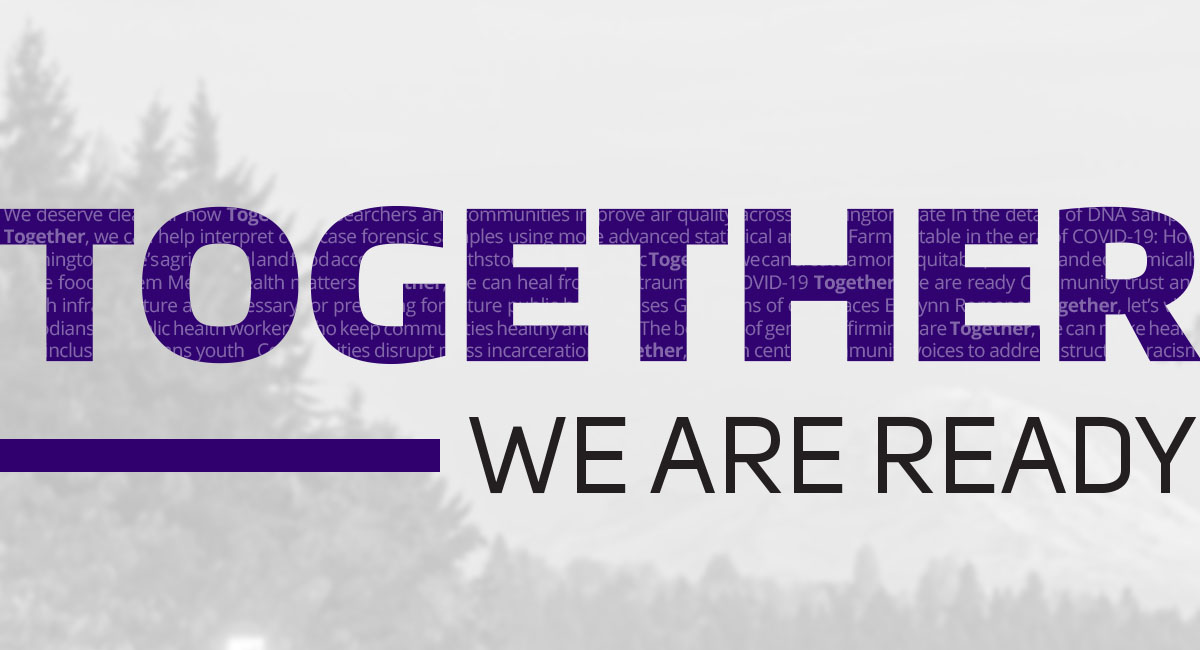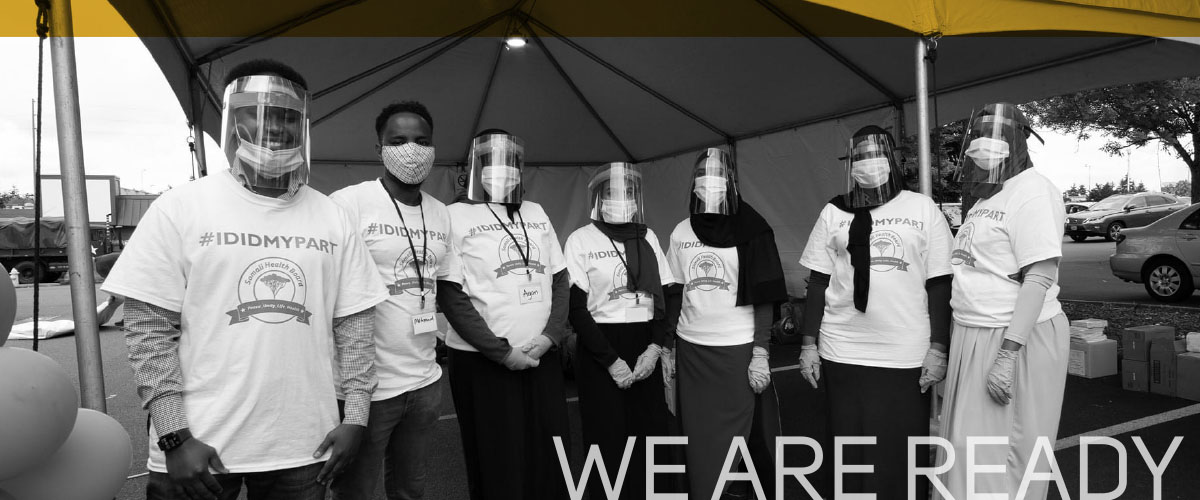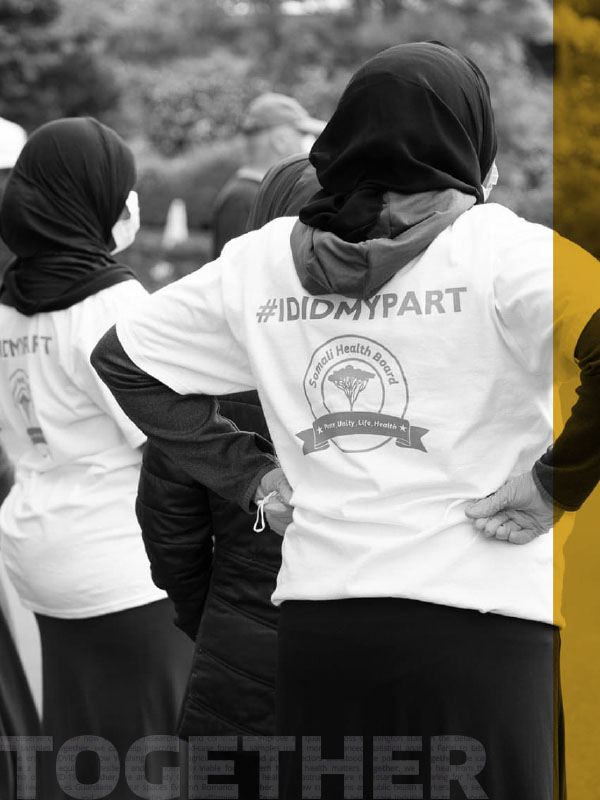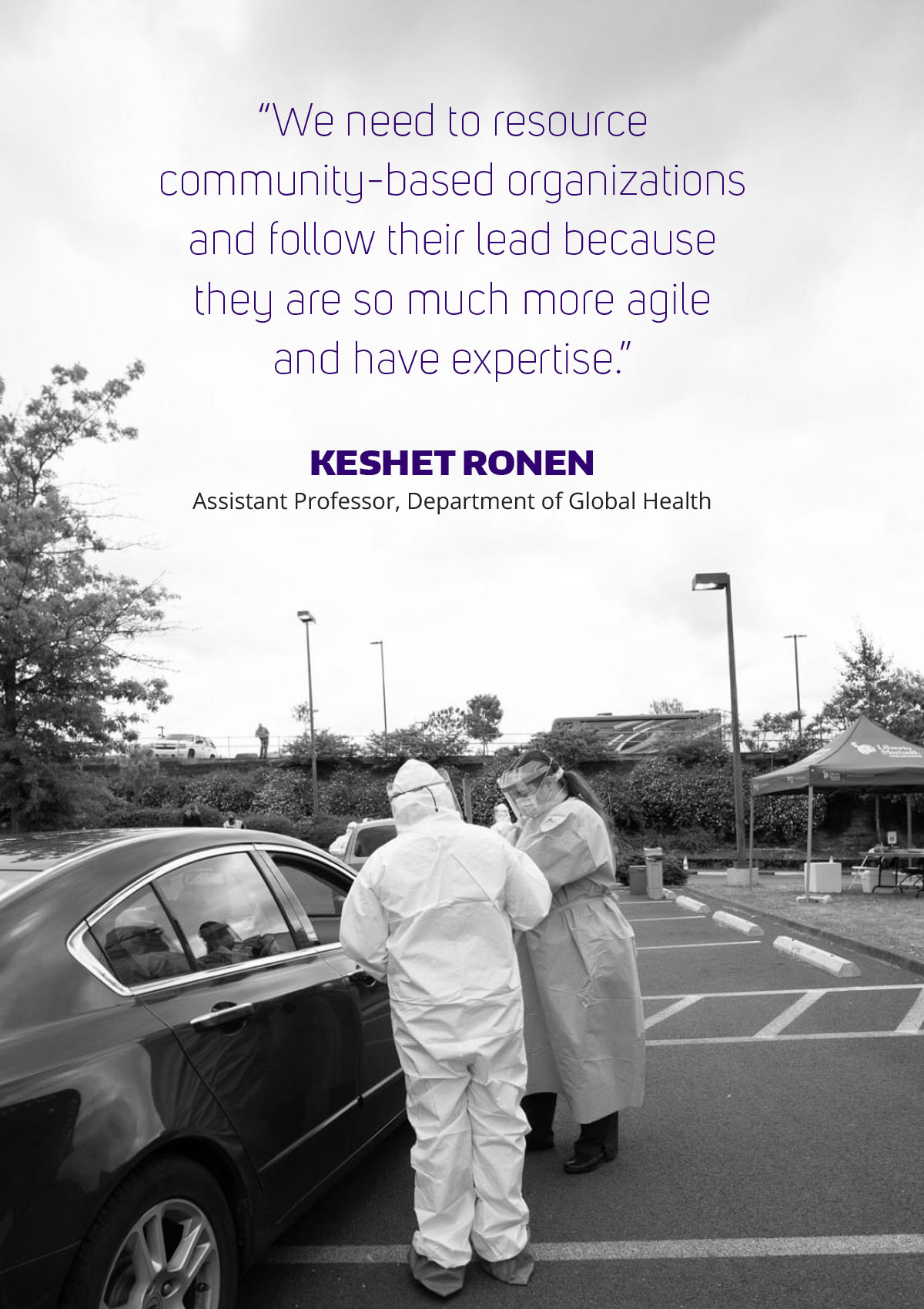
Community trust and health infrastructure are necessary to prepare for future public health crises
For years, Ahmed Ali, executive director of the Somali Health Board, has advocated for the health of Somali residents in King County, Washington. So, when COVID-19 hit, Ali asked public health leaders to bring mobile testing sites to Somali neighborhoods.
Public health leaders were skeptical that people would show up, but Ali knew his community well: to get residents tested required meeting them where they were.
Ali and his team set up two testing sites in neighborhoods south of Seattle. They informed families they could get free tests, hand sanitizer, masks and even diapers. Volunteers from the Somali community translated or answered questions.
Over a weekend, 2,500 people were tested. The effort was so successful, these neighborhood pop-up testing sites became a model for public health leaders to reach communities. Later, the Somali Health Board partnered with University of Washington School of Public Health researchers to study barriers to testing and used the results to improve vaccine distribution.
“The moral of the story is that public health needs to understand and appreciate the organizations who are on the ground and serving the communities,” Ali says. “How do we structure that moving forward to make sure they get the resources they need?”
While the Somali Health Board was a success story in supporting its community during the pandemic, the larger public health system was not prepared for COVID-19. Understanding community needs, combating misinformation and distributing vaccines equitably took months, if not years, to develop.
There’s much we can learn from this experience to help us through the next public health crisis. Students, alumni, researchers and community partners who have been supporting their neighborhoods during the pandemic have some solutions so that equity is centered, communities are resourced and public health systems are trusted.
They’ve found that preparing for the next pandemic also makes us better prepared to support public health every day.

Public health requires alliances
Pandemics are not going away. The past 20 to 30 years have seen a dramatic increase in the frequency, severity and reach of infectious disease epidemics, the vast majority of which originated in animals: West Nile, SARS, bird flu, H1N1 influenza, MERS, Ebola, Zika, and now, of course, COVID-19.
Instead of tackling pandemics in a reactionary way, it’s time to be proactive. The UW Alliance for Pandemic Preparedness, led by Professors Judith Wasserheit and Peter Rabinowitz, gathers experts across the UW to collaborate with partners in Washington state and in low- and middle-income countries to design, coordinate and translate research to strengthen pandemic preparedness, response capacity and other related activities. Wasserheit advocated for creating this united front long before COVID-19 began, and at a time when experts didn’t view pandemics as a priority.
“If we want to prevent and respond to pandemics, we need to understand why and how viruses with pandemic potential emerge and spread, and what combination of countermeasures works best in each kind of community,” Wasserheit says. “We have got to have a much more strategic, integrated system to deal with the next pandemic — one that proactively coordinates our efforts in several critical areas.”
These strategic areas include:
- Assessing the risk of emerging new or recurring infections that have pandemic potential, and the risk of local and national spread
- Developing, testing and delivering biomedical innovations (like vaccines, drugs and diagnostic tests)
- Designing, evaluating and implementing policy and behavioral interventions (like masks)
- Strengthening workforce capacity
- Coordinating communication to share rapidly evolving information clearly and in a timely way
New infectious diseases have emerged as humans and animals have come in closer contact through population growth, intensifying agricultural production, global travel, climate change and habitat destruction
That’s why Alliance for Pandemic Preparedness members are playing key roles in the U.S. Agency for International Development’s Discovery & Exploration of Emerging Pathogens – Viral Zoonoses, or DEEP VZN project, being led by Washington State University. UW researchers are partnering with in-country teams in Africa, Asia and Latin America to sample animals and humans to detect new pathogens with pandemic potential. The project will also identify drivers of disease emergence.
“This calls for a whole new approach to infectious diseases and pandemic preparedness,” Rabinowitz says. “We have to think about a lot of different factors converging in the way we are producing food, conserving ecosystems and coexisting with animals in shared environments. We need sophisticated, integrated approaches to these complex events that are happening.”
In considering our preparedness for future pandemics, Wasserheit and Rabinowitz are optimistic about new technology to assess risk, sequence viruses, develop vaccines, diagnostics, and therapies, and track pathogens around the world. More work is needed, however, to understand our changing relationship with animals, food production and climate change, and bring communities together without sowing division.
“My hope is that we continue to build on the positives and all that we have learned from COVID as we come through to the other side of this pandemic,” Wasserheit says. “I’m pretty optimistic about this.”

Public health requires trust and strong communication
About a year into the pandemic, scientists created vaccines. They made them faster than any vaccine in history. They used cutting-edge mRNA technology. They were highly effective in preventing disease. But as Jen Nelson, affiliate professor of biostatistics put it, that was not enough.
“There is so much that has to go around that one piece of amazing science to solve the problem,” Nelson says. “You have to be able to communicate; that’s what you need to build trust.”
Communication was one of the biggest challenges of the pandemic. Misinformation abounded about the origin of the virus, the creation of vaccines, and the best ways to keep oneself safe. Misinformation led to global discrimination, division and mistrust.
Nelson works as a biostatistician with the Food and Drug Administration and the Centers for Disease Control and Prevention (CDC) on vaccine safety and effectiveness. During the pandemic, she served in a working group that made safety recommendations to the CDC. She reviewed data — electronic medical records, COVID-19 health apps, doctor or patient reports, and statistics from partnering countries — for any issues that might have arisen pertaining to vaccine safety.
While the data indicated the vaccines posed minimal risk, Nelson and her fellow scientists weighed how to communicate their confidence in the vaccine’s safety, while also being cautious in case future issues arose. If they were too confident and something went wrong, that could erode public trust. But if they were too cautious, people might not feel safe getting a vaccine.
Some researchers wanted better communication about how the scientific process was working behind the scenes to evaluate safety and inform policy. When rules about wearing masks changed based on new research, some people saw that as indecisive leadership. In reality, that was the scientific process at work gathering more information and leading to better-informed decisions.
“Sometimes you make a decision that is not the optimal decision, but they are formed based on the best information at the time,” says Brandon Guthrie, associate professor of global health and epidemiology and a member of the UW Alliance for Pandemic Preparedness. “It’s as much art as science, figuring out how to communicate effectively to a general audience.”
Guthrie helped lead an Alliance effort, in collaboration with the Washington State Department of Health, to produce the COVID-19 Literature Situation Report, a daily digest summarizing the latest COVID-19 research for local and state public health professionals. The digest had more than 5,600 subscribers.
Guthrie says he hopes that in future pandemics or emergency situations, more policy decisions can be made based on the latest and most accurate data. He says research showed it was safe to open schools in the fall of 2020 with minimal transmission, yet many schools remained closed to in-person learning while restaurants, gyms and bars opened.
Public health requires health equity and community knowledge
After their successful pop-up COVID-19 testing sites, the Somali Health Board used its successful model for vaccinations.
At one of these events, a group of Muslim Somali women approached then-undergraduate Ayan Mohamed and asked if there was a private place where they could get their vaccines. Mohamed led them to such an area and answered their questions. Afterward, one woman returned to Mohamed, thanked her and said a prayer for her.
“There’s a lack of understanding of what BIPOC [Black, Indigenous and people of color] communities go through and what disparities are exacerbated in pandemics,” says Mohamed, now a Master of Public Health student. “How are you going to know what a community is going through if members are not given a space or voice to speak on their experiences?”
The COVID-19 pandemic exacerbated health disparities experienced by communities of color. Some were more likely than white populations to get COVID-19, be hospitalized for severe illness or die, according to the Washington State Department of Health.
Through a grant from the UW Population Health Initiative, a research partnership between the Somali Health Board and the UW School of Public Health investigated health equity barriers the King County Somali community faced during the pandemic. They found that misinformation, distrust of medical institutions and a lack of transportation were barriers to testing.
However, having members of the Somali community present at testing events helped build trust. Students like Mohamed could translate for people who didn’t speak English and address concerns.
“People are most likely to trust information that comes from experts who look like them or are part of their community,” says Sabrina Ebengho (Public Health-Global Health ’21), who was a policy and data coordinator at the Somali Health Board. “But that representation needs to be accompanied with built trust and continued community presence and engagement so the community can trust that you have their best interests in mind.”
While the study was on the Somali community, the findings have implications for how public health leaders can better work in partnership with groups that have historically faced marginalization, says Keshet Ronen, assistant professor of global health, who helped lead the research in partnership with Ahmed Ali.
“There’s a pattern of communities knowing what’s up, figuring out a solution, and eventually public health infrastructure catches up with it,” Ronen says. “We need to resource community-based organizations and follow their lead because they are so much more agile and have expertise.”
In addition to Ebengho, students Nasra Mohamed, Najma Abdi, Ayan Mohamed, Asiya Ahmed and Andrea Scallon, as well as School of Public Health faculty Kate West, participated in the research.
Students found that bringing an anti-racist lens to research like this is critical to addressing historical trauma.
“When you do research in marginalized spaces, how do you have an anti-racist perspective?” says Abdi, an undergraduate student. “In terms of shifting power, it’s about including the voices of the community in the work you want to do.”
Public health requires strong infrastructure and consistent support
Chronic underfunding of public health infrastructure means that emergencies divert professionals’ critical everyday work and cause disruptions across the system, says Janet Baseman, professor of epidemiology at the UW School of Public Health.
When Eliza Ramsey began her Master of Public Health program, it was six months into the pandemic. She began tracking food-borne illnesses with the Washington State Department of Health, filling in for epidemiologists who had been diverted to responding to the virus. With limited staff, food-related illness cases and outbreaks couldn’t be traced as quickly as needed.
Ramsey and Baseman, who is also the co-director of the Washington state-based Integrated Food Safety Center of Excellence, are now working on a study to understand how COVID-19 disruptions affected food-borne disease surveillance.
“We want public health to be resourced well enough so that foundational public health services needed in our communities are not pushed to the side every time there is a pandemic or other emergency,” Baseman says. “This is important for population health, for our communities, not just for the functioning of the public health system.”
Some of the answers to how we can support public health infrastructure long term can be found in the Centers of Excellence model, Baseman says.
The Integrated Food Safety Center of Excellence that Baseman co-leads is one of five regional centers in the nation focused on surveillance of food-borne illnesses. The centers were created by the Food Safety Modernization Act in 2011, when Congress recognized food safety was so important that it required coordinated surveillance and prevention activities. The law called for partnerships between academic institutions and public health departments, and supported this partnership with funding.
The partnerships create an ecosystem where community health professionals collaborate to address public health crises, whether that’s food-borne illnesses or pandemics.
The centers also train the future workforce, including students like Ramsey, who, post-grad, will help build the next generation of data infrastructure with a state department of health. Ramsey says she hopes students can be viewed as a valuable resource in public health, even beyond pandemics.
“I feel immensely grateful that as a student at the UW, I have this opportunity to work in a space that I ultimately want to go get hired in,” she says.

Public health requires meeting people where they are
Communities throughout the U.S. responded very differently to the COVID-19 pandemic. Some embraced vaccines and mandates while others rejected them. Division ran deep.
VillageReach is one organization that found ways to build trust between communities and public health institutions. As Erin Larsen-Cooper (MPH, ’12) puts it, building trust requires meeting people where they’re at, geographically and philosophically.
Larsen-Cooper is a director and team lead at VillageReach, a nonprofit that improves health care access globally. When the pandemic hit, Larsen-Cooper and her team of other School of Public Health alums pivoted their work to support Washington state’s local health jurisdictions.
“A big lesson we learned is the need for hyperlocal context,” says Emily Gibson (MPH, ’21), health systems associate at VillageReach. “We hear a lot from counties [outside of Seattle], ‘We are not like King County.’ Folks want us to know their barriers are different.”
Julia Guerette (MPH, ’19), data analytics manager at VillageReach, helped local health departments use ZIP code-level data to understand their community’s vaccine uptake, identifying where language barriers or a lack of transportation could cause barriers to access.
Some communities didn’t trust their local health departments, but instead trusted police, fire departments or clergy. Knowing this, health workers could collaborate with trusted messengers to encourage their community to get vaccinated or wear masks.
“We have an opportunity now to call people in and build up public health institutions as trusted parts of communities,” Gibson says. “The way we can be most successful is making people feel called in and not alienated. If they have a hard time connecting with all the recommendations, we can find where they do connect.”
Building a pipeline of trust, health infrastructure and good relationships — and doing it now — supports community health, whether or not there’s a public health crisis.
"The solutions we’re working on today should be here tomorrow,” Guerette says. “Public health is still going on outside of COVID; all these other problems we’ve had for decades, we still need to address. How do we build systems that are sustainable, and not just for COVID?”